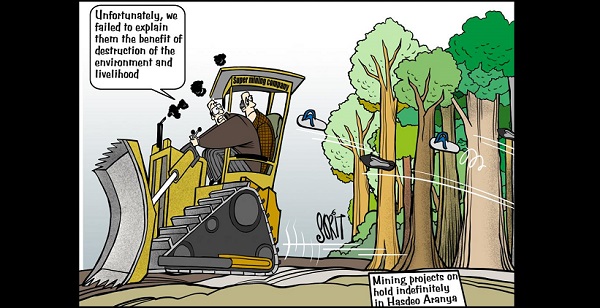Hasdeo Protests

From Current Affairs Notes for UPSC » Editorials & In-depths » This topic
IAS EXPRESS Vs UPSC Prelims 2024: 85+ questions reflected
Over the past year, the Hasdeo forests, known as the ‘Lungs of Chhattisgarh’, have been in news for the protests erupting over the mining project. In July, the Chhattisgarh Legislative Assembly unanimously passed a resolution urging the central government to cancel the allocation of coal mining blocks in the region.
Why is the Hasdeo Aranya region important?
- The Hasdeo Aranya is a forest in the catchment area of the Hasdeo River, the largest tributary of the Mahanadi River that originates in Chhattisgarh and flows through Odisha before emptying into the Bay of Bengal.
- It spans across an area of 1,878 sq km, covering several districts- Korba, Sujapur, and Sarguja- of Chhattisgarh.
- The forest is ecologically sensitive given its rich biodiversity and its role as a migratory corridor for elephants. It is also home to some 18 threatened species.
- It is home to some 10,000 Adivasis- from Gond, Lohar, Oraon and other tribal communities. They live on 1,70,000 hectares in the region.
- The forest serves as the catchment area of the Hasdeo Bango Dam (on the Hasdeo River), that helps irrigate 3 lakh hectares of agricultural lands.
- However, it is also noted for its coal deposits. The reserve has 23 known coal mines.
What is the protest about?
- After a 2010 study by the Ministry of Coal and the Ministry of Forest and Environment, the Hasdeo region was declared a ‘No Go Area’ i.e. mining of any kind is prohibited in such regions.
- However, the Parse East Kente Basab coal mine project was given the go ahead within a year of this prohibition. The reasoning was that coal could be extracted from this region at a very cheap rate. It was also guaranteed that no new mine would be authorized in the region in the future.
- The case went to court and the approval was revoked. However, the court allowed the government to mine coal from the region until further orders came along. The matter is now pending in the Supreme Court.
- Since then, the Hasdeo protests have been ebbing and flowing for a decade now.
- Meanwhile, the environment ministry gave forest clearances for the phase I of the mining project in 2012. This approval limited the mining to 762 hectares and a 137 million tonnes reserve.
- In March, the Chhattisgarh government granted permission to Rajasthan Rajya Vidyut Utpadan Nigam to mine a 1,136 hectares under the project’s phase II.
- The coal mine falls in a V Schedule area, meaning such decision require the Gram Sabha’s authorization. The local inhabitants allege that the permission for the project’s phase II was given based on fake Gram Sabha consent documents.
- The locals filed a plea with the Chhattisgarh High Court, calling for an immediate halt to the deforestation in the area and the scrapping of the coal mine allocation. The court has questioned the hurry with which the trees were cleared and has sought a response from the state government.
- Currently, the forest clearance for phase II has been halted on account of law and order issues.
What are the recent developments?
- Recently, an MLA, Dharmjeet Singh, introduced a resolution in the Chhattisgarh State Assembly, urging the centre to cancel the block allocations in the region. The MLA had attempted to move the resolution in the last session of the state Assembly as well.
- This is a private member resolution was passed unanimously, reflecting the House’s stand on the issue. This is understandable given the intensifying anti-mining popular sentiments and the elections scheduled for next year.
- Such private member resolutions have been passed by State Assemblies in the past- for instance, the assemblies of Punjab and Kerala had adopted such resolutions to express their displeasure over the now-withdrawn farm laws.
What is the way ahead?
- Though the resolution was adopted unanimously by the members of both, the ruling party and the principal Opposition party, it isn’t expected to alter the status quo.
- The state government’s stance is that the onus is on the central government to stop the coal mining whereas the other side holds that the onus is on the state government to withdraw clearances issued to MDOs (mine developers and operators).
- According to activists, the clearances issued, under various legislations like Air Pollution Act and Water Pollution Act, by the state government function like a veto power that could stop the coal mining in Hasdeo.
Conclusion:
The recent resolution on Hasdeo coal mines has the right idea, however, it isn’t expected to have any real impact on the larger problem. The rising energy costs, not only in India but across the world, and the worsening climate situation further complicate the situation. Hence, the situation requires a balanced approach towards environmental protection and economic well-being.
Practice Question for Mains:
Elaborate the factors contributing to the decade-long protests in the Hasdeo region. (250 words)
If you like this post, please share your feedback in the comments section below so that we will upload more posts like this.


